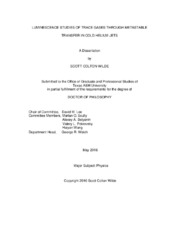| dc.contributor.advisor | Lee, David M | |
| dc.creator | Wilde, Scott Colton | |
| dc.date.accessioned | 2016-07-08T15:15:39Z | |
| dc.date.available | 2016-07-08T15:15:39Z | |
| dc.date.created | 2016-05 | |
| dc.date.issued | 2016-05-10 | |
| dc.date.submitted | May 2016 | |
| dc.identifier.uri | https://hdl.handle.net/1969.1/157067 | |
| dc.description.abstract | Among the elements, Helium has the largest steps among its internal energy structure that can keep for long periods of time, hence the metastable helium moniker. It is referred to as a “nano-grenade” in some circles because of how much energy it can deliver to a space roughly the size of an atom. This work demonstrates a method to create metastable helium abundantly and it is used to excite trace amounts of oxygen to the point where the signal received from the oxygen was larger than the signal received from the helium in a cold atomized jet. Further cooling of the jet and turbulence added by a liquid helium surface worked to increase the oxygen signal and decrease the helium signal. This work investigates the possibility of forming a strong metastable helium source from a flowing helium gas jet excited by passing through ring electrodes introduced into a cryogenic environment using evaporated helium as a buffer gas.
Prior study of luminescence from trace gases at cold helium temperatures is virtually absent and so it is the motivation for this work to blaze the trail in this subject. The absence of ionic oxygen spectral lines from the transfer of energy that was well over the first ionization potential of oxygen made for a deeper understanding of collision dynamics with multiple collision partners. This opened the possibility of using the high energy states of oxygen after metastable transfer as a lasing transition previously unavailable and a preliminary analysis suggested that the threshold for lasing action should be easily overcome if feedback were introduced by an optical cavity.
To better understand the thermodynamics of the jet it was proposed to use diatomic nitrogen as an in situ thermometer, investigating whether the rotational degrees of freedom of the nitrogen molecule were in thermal equilibrium with the surrounding environment. If the gas was truly in thermodynamic equilibrium then the temperature given by the method of using collisions of a buffer gas and the rotational temperature determined spectroscopically should be in agreement. It was found that metastable transfer from helium in the jet provides enough energy to create a population of hot molecules of nitrogen that never reach thermal equilibrium with the buffer gas which is almost entirely made up of ground state helium atoms. This effect can be corrected for by adding some significant changes to the optical setup but are not outside the realm of possibility as they have been designed and built for other experiments. Therefore the rotational spectra of nitrogen could be used as an in situ thermometer at cryogenic temperatures with metastable helium present provided the hot molecule contribution due to collisions of the second kind of nitrogen and helium is measured and removed. | en |
| dc.format.mimetype | application/pdf | |
| dc.language.iso | en | |
| dc.subject | metastable | en |
| dc.subject | helium | en |
| dc.subject | cold jet | en |
| dc.subject | trace gases | en |
| dc.subject | oxygen | en |
| dc.subject | first positive | en |
| dc.subject | nitrogen | en |
| dc.subject | luminescence | en |
| dc.title | Luminescence Studies of Trace Gases Through Metastable Transfer in Cold Helium Jets | en |
| dc.type | Thesis | en |
| thesis.degree.department | Physics and Astronomy | en |
| thesis.degree.discipline | Physics | en |
| thesis.degree.grantor | Texas A & M University | en |
| thesis.degree.name | Doctor of Philosophy | en |
| thesis.degree.level | Doctoral | en |
| dc.contributor.committeeMember | Belyanin, Alexey | |
| dc.contributor.committeeMember | Pokrovsky, Valery | |
| dc.contributor.committeeMember | Scully, Marlan O | |
| dc.contributor.committeeMember | Wang, Haiyan | |
| dc.type.material | text | en |
| dc.date.updated | 2016-07-08T15:15:39Z | |
| local.etdauthor.orcid | 0000-0002-7027-4803 | |


